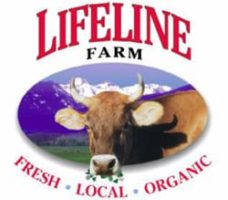Lifeline Farm

| Rating |      |
| Farm/Brand Headquarters | Victor, MT |
| Products | Cheese |
| Website | www.lifelinefarm.com |
| Market Area | ID, MT, OR, WA, Web Sales |
| Total Score | 1540 |
Lifeline Farm Inc. was founded in 1978 in Victor, Montana by a group of young men and women who wished to grow nutritious, organic and biodynamic foods to nourish people in their community and throughout the US. Originally, Lifeline grew field-scale vegetable crops, selling vegetables in Montana and on the West Coast, off the farm and operating a market stand. The dairy was added in 1984 in order to diversify the operation but also to provide a source of on-farm fertility. We manage a herd of about 400 Brown Swiss cows, bulls, calves and steers that make up Lifeline Farm Inc. Long revered by the Swiss as an excellent, dual-purpose breed, the Brown Swiss produce rich milk, which is used to make cheese, butter and bottled milk all done at our Creamery, as well as delicious beef, which is sold throughout Montana. Lifeline Farm also “recycles” many feeds by raising pigs which are then sold as pork cuts and in home style sausage.
| Criteria | Points | Comment |
|---|---|---|
| TOTAL (possible score is 1600 plus extra credit) | 1540 | 5-Cow Rating | Top-Rated      |
|
Farmstead dairies earn the most points. Corporations that have a history of skirting the organic rules receive the fewest. Ownership structure | 100 | Farmer-owned farm |
|
Farms that produce 100% of their milk receive the most points. Milk from "open market" or known confinement dairies receive the fewest. Milk Supply | 100 | Single farm |
|
100% organic farms receive the most points. Split operations with conventional dairy on the same property receive the fewest. Organic Production | 100 | Brand only markets organic |
|
Farms that completed the survey in detail received the most points.
Disclosure of Information for Verification | 100 | Full disclosure |
|
Points determined by integrity of the brand’s organic certifier. Organic Certification | 100 | Stellar Certification Services |
|
Animal Welfare Approved and Biodynamic certifications receive the most bonus points. Producers are not penalized for not having additional certifications beyond organic. Other Labels/Standards | 100 | Real Organic Project Certified, Biodynamic Certified |
|
100% grass-fed with independent verification of standards Grass-fed | 80 | Exceeds USDA percent intake requirements |
|
No points are given for this but the information may be useful to certain consumers looking to avoid soy. Soy Free Ration? | Yes | |
|
Sliding scale based on policies, enforcement, acreage/cow, days/year on pasture, and permissible exemption. Pasture | 100 | Excellent pasture compliance |
|
One time/day receives the most points. Two times per day is standard. Times Milked | 90 | Two times a day (standard protocol on legitimate organic dairies) |
|
Lower cull rate scores better, with under 10% receiving the most points. Cull/death Rate | 100 | Very low cull and death rate |
|
Farms with closed herds receive the most points. Farms that sell organic calves and buy conventional replacements receive the fewest. Replacements | 100 | Closed herd |
|
Standard practice is removing calves shortly after birth, with extra points given for unique ways of managing calves
Calves | 85 | Calves raised first few weeks with mothers |
|
Farms that prohibit antibiotics receive the most points. Farms that allow young stock to receive antibiotics (under one year), receive the fewest.
Antibiotic Use | 100 | No antibiotic use |
|
No hormones is the standard, however some farms do use oxytocin for therapeutic purposes. Hormone Usage | 85 | No routine hormone use, but some may be used to prevent infection from retained placenta (no growth hormones are ever usedb in organics) |
|
Farmstead dairies (owner lives on-site) receive the most points. Fewer points are given as oversight declines. Farm Support | 100 | Single farm |
|
All ingredients sourced from inside the organization or on the farm receives the highest points. Ingredients from confinement factory farms and/or imported ingredients receive the fewest. Procurement of Ingredients | 100 | No outside dairy ingredients used |
|
Various levels of extra credit given for 1) providing full organic systems plan, 2) providing details on all farms (multi-farm brands, details on largest five required), and 3) sourcing feed on-farm or domestically. Extra Credit | 0 | None |

